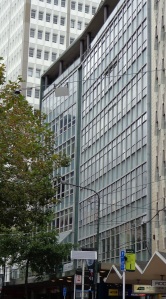One interesting talk I went to last weekend as part of the ‘Capital 150’ celebrations was on the topic of refugee architects who came to New Zealand from Europe just before World War Two. The talk was given by Linda Tyler from Auckland and was in conjunction with an exhibition at the Holocaust Centre in Wellington. These architects were key figures in the introduction of modernism into Wellington architecture at this period.
The best known of these architects was Ernst Plischke (he sometimes dropped the ‘c’ and became Plishke; 1903-1992). Although not Jewish himself, his wife was, and his association with the socialist wing of the Werkbund caused employment opportunities in Austria under Nazi occupation to dwindle. They emigrated to New Zealand arriving in May 1939, but were nevertheless regarded as enemy aliens during the war.
Plischke was employed by the Department of Housing Construction as an architectural draughtsman. He refused to sit RIBA (Royal Institute of British Architects) exams and therefore could not practice independently as an architect in NZ (he had to have a partner when he did go into private practice). At the Department of Housing Construction he and other European immigrants, such as Fritz Feuer (Frederick Farrar) and Friedrich Neumann (Fred Newman), worked under Gordon Wilson as chief architect on designs for multiple-unit housing blocks to be built by the government in Auckland and Wellington. The 1957 building, Massey House (photo above), designed with Cedric Firth was the first glass curtain-wall building in New Zealand and his 1940 Kahn House is a Category 1 heritage listed building.
Equally important, were the effects of his “charismatic public lecturing style and of his illustrated publications on the principles of modern design.”[1] His most influential writing first appeared in the Army Education and Welfare Service bulletin About houses in 1943; which was then expanded to become Design and Living, published under the name E. A. Plishke by the Department of Internal Affairs in 1947. He was involved in helping found the Architectural Centre in Wellington in 1946, writing regularly for their magazine Design Review from 1948 to 1954 and teaching town planning and architectural design at their summer schools each year. In her lecture, Linda Tyler spoke more about his wife Anna, who was a garden designer, her landscape designs complementing many of Ernst’s houses.
Less well-known are some of the other refugee architects, but they are also the focus of the exhibition: Helmut Einhorn, Henry Kulka, Max Rosenfeld and Fred Neumann/Newman. The research for the exhibition information boards and model buildings were done by Victoria University students. There were 14 refugee architects in New Zealand in 1945, plus some other Jewish architects such as Bob Fantl who was Czech-born but trained in NZ.[2]
Helmut Einhorn and his wife arrived in New Zealand in July 1939. At the end of the war he joined the Ministry of Works and designed the hydro-electric power stations at Benmore and Aviemore (with the Dutch architect Christiaan Vallenduuk). In the 1960s, despite being opposed to the Wellington urban motorway, he worked to make the project as sympathetic as possible to the Bolton Street cemetery that it went through. His own home built in 1951 embodied his modernist ideas and the garden was designed by his wife Ester.
Fred Newman also worked at the Department of Housing and later Ministry of Works, and like the other refugees was involved with the Architectural Centre (still active in Wellington). Henry Kulka trained under Adolf Loos and later became his chief biographer and architectural partner. In 1931 Kulka coined the term ‘raumplan’ (literally floor plan) which involved the planning of interior spaces by modulating ceiling and floor levels for functional and psychological effects.[3] Kulka worked for Fletcher Construction in Auckland from 1940 to 1960, eventually becoming their chief architect. He designed the Halberstam House in Wellington in 1947-48 (photo below).
Photo Credit: From advertising for the book Modern: New Zealand Homes from 1938 to 1977. Ed Jeremy Hansen.
Many of these architects also published. Max Rosenfeld’s book ‘The New Zealand House’ went through 13 editions and his (unsigned) house plans were often used.[4]
Linda Tyler mentioned that despite the New Zealand Labour Government’s immigration policy being highly restrictive prior to and during World War Two, the architects were lucky that the government was committed to a social housing programme, including high-density apartment blocks, which gave them employment opportunities.
Footnotes:
[1] Linda Tyler. ‘Plischke, Ernst Anton’, from the Dictionary of New Zealand Biography. Te Ara – the Encyclopedia of New Zealand, updated 30-Oct-2012 URL: http://www.TeAra.govt.nz/en/biographies/5p31/plischke-ernst-anton
[2] Exhibition information panel entitled “Modernism in Wellington”
[3] Information panel at the exhibition.
[4] Information panel, “Modernism in Wellington”.


